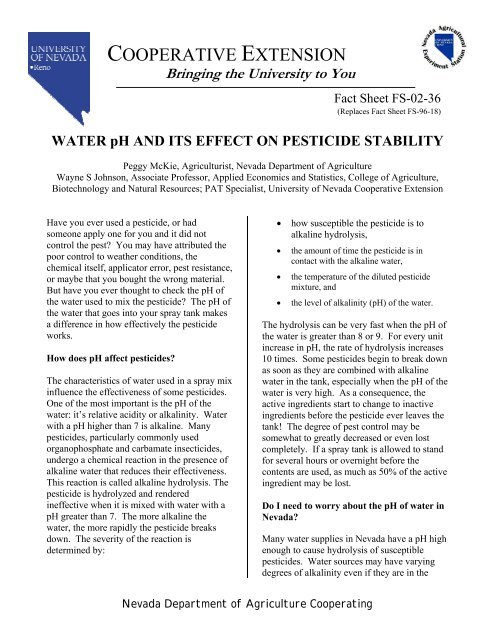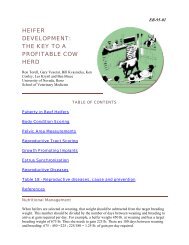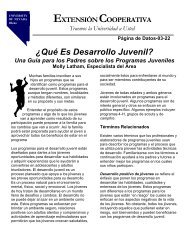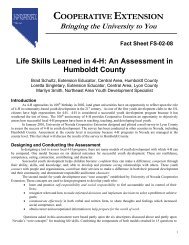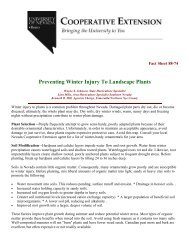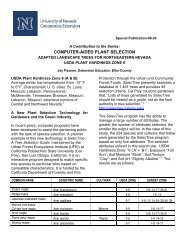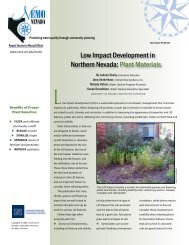WATER pH AND ITS EFFECT ON PESTICIDE STABILITY
WATER pH AND ITS EFFECT ON PESTICIDE STABILITY
WATER pH AND ITS EFFECT ON PESTICIDE STABILITY
Create successful ePaper yourself
Turn your PDF publications into a flip-book with our unique Google optimized e-Paper software.
COOPERATIVE EXTENSI<strong>ON</strong><br />
Bringing the University to You<br />
Fact Sheet FS-02-36<br />
(Replaces Fact Sheet FS-96-18)<br />
<strong>WATER</strong> <strong>pH</strong> <strong>AND</strong> <strong>ITS</strong> <strong>EFFECT</strong> <strong>ON</strong> <strong>PESTICIDE</strong> <strong>STABILITY</strong><br />
Peggy McKie, Agriculturist, Nevada Department of Agriculture<br />
Wayne S Johnson, Associate Professor, Applied Economics and Statistics, College of Agriculture,<br />
Biotechnology and Natural Resources; PAT Specialist, University of Nevada Cooperative Extension<br />
Have you ever used a pesticide, or had<br />
someone apply one for you and it did not<br />
control the pest? You may have attributed the<br />
poor control to weather conditions, the<br />
chemical itself, applicator error, pest resistance,<br />
or maybe that you bought the wrong material.<br />
But have you ever thought to check the <strong>pH</strong> of<br />
the water used to mix the pesticide? The <strong>pH</strong> of<br />
the water that goes into your spray tank makes<br />
a difference in how effectively the pesticide<br />
works.<br />
How does <strong>pH</strong> affect pesticides?<br />
The characteristics of water used in a spray mix<br />
influence the effectiveness of some pesticides.<br />
One of the most important is the <strong>pH</strong> of the<br />
water: it’s relative acidity or alkalinity. Water<br />
with a <strong>pH</strong> higher than 7 is alkaline. Many<br />
pesticides, particularly commonly used<br />
organophosphate and carbamate insecticides,<br />
undergo a chemical reaction in the presence of<br />
alkaline water that reduces their effectiveness.<br />
This reaction is called alkaline hydrolysis. The<br />
pesticide is hydrolyzed and rendered<br />
ineffective when it is mixed with water with a<br />
<strong>pH</strong> greater than 7. The more alkaline the<br />
water, the more rapidly the pesticide breaks<br />
down. The severity of the reaction is<br />
determined by:<br />
• how susceptible the pesticide is to<br />
alkaline hydrolysis,<br />
• the amount of time the pesticide is in<br />
contact with the alkaline water,<br />
• the temperature of the diluted pesticide<br />
mixture, and<br />
• the level of alkalinity (<strong>pH</strong>) of the water.<br />
The hydrolysis can be very fast when the <strong>pH</strong> of<br />
the water is greater than 8 or 9. For every unit<br />
increase in <strong>pH</strong>, the rate of hydrolysis increases<br />
10 times. Some pesticides begin to break down<br />
as soon as they are combined with alkaline<br />
water in the tank, especially when the <strong>pH</strong> of the<br />
water is very high. As a consequence, the<br />
active ingredients start to change to inactive<br />
ingredients before the pesticide ever leaves the<br />
tank! The degree of pest control may be<br />
somewhat to greatly decreased or even lost<br />
completely. If a spray tank is allowed to stand<br />
for several hours or overnight before the<br />
contents are used, as much as 50% of the active<br />
ingredient may be lost.<br />
Do I need to worry about the <strong>pH</strong> of water in<br />
Nevada?<br />
Many water supplies in Nevada have a <strong>pH</strong> high<br />
enough to cause hydrolysis of susceptible<br />
pesticides. Water sources may have varying<br />
degrees of alkalinity even if they are in the<br />
Nevada Department of Agriculture Cooperating
same hydrologic basin. If the <strong>pH</strong> of your water<br />
is higher than 7.5, it is alkaline enough to affect<br />
some pesticides. Use a <strong>pH</strong> meter or <strong>pH</strong> test kit<br />
such as those used for testing swimming pool<br />
water to accurately determine the <strong>pH</strong> of the<br />
water. Test papers, like hydrion or litmus can<br />
be inaccurate and should not be used. Both<br />
surface and ground water <strong>pH</strong> can and do<br />
change with time. The <strong>pH</strong> may fluctuate<br />
seasonally. It is a good practice to test the <strong>pH</strong><br />
of the water just prior to mixing up your spray<br />
solution. If your water supply is alkaline, with<br />
a <strong>pH</strong> of 7.5 or greater, you can and should<br />
lower the <strong>pH</strong>, particularly if you are using a<br />
pesticide that is sensitive to high <strong>pH</strong>. A <strong>pH</strong> of<br />
4 to 7 is recommended for mixing most<br />
pesticides. You can adjust your spray solutions<br />
to the 4 to 7 <strong>pH</strong> range with commercially<br />
available buffering agents.<br />
What is a buffering agent?<br />
A buffering agent changes the <strong>pH</strong> of a spray<br />
solution to a prescribed level and keeps it there.<br />
They are often straight acidifying agents, but<br />
many are sold as combination products<br />
containing surfactants, trace elements or other<br />
fertilizers. Examples of commercially<br />
available buffering agents are Buffer-X ® (Kalo,<br />
Inc.), Buffer ® (Ladda Co.), Spray-Aide ® (Miller<br />
Chemical), and Buffercide ® (Custom<br />
Chemicals). Buffering agents prevent pesticide<br />
hydrolysis during mixing and storage in the<br />
tank, until the spray is applied and the water<br />
has evaporated away.<br />
decomposed by alkaline hydrolysis much more<br />
rapidly than others.<br />
Many manufacturers provide information on<br />
the rate at which their products hydrolyze.<br />
This rate is usually expressed as ‘half-life’ or<br />
the time it takes for 50% of the product to<br />
breakdown (hydrolyze), Table 1. Dimethoate<br />
(Cygon) has a half-life of 1 hour at a <strong>pH</strong> of 9.<br />
This means that if the <strong>pH</strong> of your spray water is<br />
9, and one hour elapses between the times you<br />
mix-up the dimethoate and spray it out, 50% of<br />
the active ingredient is already lost! However,<br />
if your water has a <strong>pH</strong> of 6, it is not likely that<br />
any significant loss of active ingredient will<br />
have occurred in one hour.<br />
Are there any materials that should not be<br />
mixed with a buffering agent?<br />
Yes! Under no circumstances should sprays<br />
containing fixed copper or lime fungicides,<br />
including Bordeaux, copper oxide, basic copper<br />
sulfate, copper hydroxide, etc. or lime sulfur be<br />
mixed with a buffering agent, or plant damage<br />
may occur, Figure 1.<br />
How will I know if a product should be<br />
buffered?<br />
If the product label tells you to avoid alkaline<br />
water or materials, the spray mixture will<br />
benefit by adjusting the <strong>pH</strong> to 6 or slightly<br />
lower. In general, insecticides are more<br />
susceptible to hydrolysis than fungicides and<br />
herbicides. Among insecticides, the<br />
organophosphates and carbamates are<br />
Figure 1. Do not mix buffering agents with<br />
lime sulfur or fungicides that contain lime<br />
or copper.
Table 1. The Half-life of Selected Pesticides at Different <strong>pH</strong> Values 1<br />
Pesticide<br />
Half-life Time 2 at Different Solution <strong>pH</strong>s<br />
Common Name Trade Name 3 4 5 6 7 8 9 10 11<br />
acephate Acephate Pro 65d 16d<br />
azin-phos methyl Guthion 17d 10d 12h<br />
bendiocarb Ficam 4d<br />
carbaryl Sevin 125d 27d 2-3d 1-3d<br />
carbofuran Furadan 200d 40d 5d 3d<br />
chlorothalonil Daconil Stable below <strong>pH</strong>7 38d<br />
diazinon Knox-Out 31d 185d 136d<br />
dimethoate Cygon 12h 1h<br />
disulfoton Di-syston 60h 32h 7h<br />
malathion Digon 8d 3d 19h 2h<br />
methomyl Lannate 54w 38w 20w<br />
phosmet Imidan 13d 12h 4h 1m<br />
methylparathion Declare 690d 120d 29h 3h<br />
trichlorfon Dylox 4d 6h 1h<br />
1. These figures are generalized estimates and reflect trends, but half-life times vary considerably. Hydrolysis depends<br />
on other factors besides the <strong>pH</strong> of the solution, including temperature, the presence of other pesticides and<br />
adjuvants in the spray tank, and the formulation of the pesticide.<br />
2. w = weeks, d = days, h = hours, m = minutes.<br />
How much buffering agent should be used?<br />
To determine how much buffering agent should be<br />
used in the spray tank depend on three things: 1)<br />
the <strong>pH</strong> of the water, 2) the volume of the mixture<br />
that will be made up for the application and 3) the<br />
buffering agent used—its type and effective<br />
concentration. Once the <strong>pH</strong> of the water is<br />
determined, read and closely follow the directions<br />
on the label of the buffering agent. Follow the<br />
directions in Table 2 for help.<br />
Summary<br />
If your water source has a <strong>pH</strong> above 7, addition of a<br />
buffering agent to the spray solution is an easy and<br />
economical way to guarantee maximum results<br />
from your pesticide application. Know the <strong>pH</strong> of<br />
water that is used with your pesticides and make the<br />
appropriate buffering adjustments. Whenever<br />
possible, use pesticides that do not hydrolyze in<br />
alkaline water. That information is available on the<br />
label.
Table 2. Testing and Adjusting the <strong>pH</strong> of Alkaline Water Used for Mixing Pesticides 1<br />
Measure <strong>pH</strong> with an electronic <strong>pH</strong> meter or swimming pool test kit. Test paper used for <strong>pH</strong> testing is less<br />
reliable and should not be used.<br />
Water <strong>pH</strong> Testing Procedures:<br />
1. Collect a sample of water from the same source that will be used to fill the spray tank. Use a clean<br />
container and rinse it several times with the same water.<br />
2. Check the <strong>pH</strong> of the water using a <strong>pH</strong> meter or test kit. Follow the manufacturer’s directions.<br />
<strong>pH</strong> 3.5-6.0:<br />
<strong>pH</strong> 6.1-7.0:<br />
Above <strong>pH</strong> 7.0:<br />
<strong>pH</strong> Adjustment Procedure:<br />
Satisfactory for spraying and short-term (12 to 24 hours) storage of<br />
most spray mixtures in the spray tank.<br />
Adequate for spraying most pesticides. Do not leave the spray mixture in the<br />
tank more than 1 to 2 hours or the pesticide may lose its effectiveness.<br />
Add buffer or acidifier<br />
1. Using a standard eyedropper, add 3 drops of buffer or acidifier to a measured pint of water.<br />
2. Stir well with a clean glass rod or other clean, non-porous utensil.<br />
3. As described above, check the <strong>pH</strong> and compare the results to the <strong>pH</strong> ranges given in number two.<br />
4. If further adjustment is needed, repeat steps 1 through 3. Repeat until the <strong>pH</strong> is satisfactory.<br />
Record how many times 3 drops were added to bring the solution to the proper <strong>pH</strong>!<br />
Correct <strong>pH</strong> in Spray Tank:<br />
1. Before adding pesticides to the sprayer, fill the tank to the level required for the application.<br />
2. For every 100 gallons of water in the spray tank, add 2 ounces of buffer for each time 3 drops<br />
of buffer were used in the jar test above. Add buffer or acidifier to water while the agitators are<br />
running. If the tank is not equipped with an agitator, stir or mix the solution well by hand.<br />
3. Collect a sample of the water in the sprayer and check the <strong>pH</strong> to be certain it is correct. Add<br />
more buffer if necessary and recheck the <strong>pH</strong>.<br />
4. Once the <strong>pH</strong> is correct, add the pesticides to the spray tank.<br />
1. From The Safe and Effective Use of Pesticides, University of California Statewide Integrated Pest Management Project.<br />
Chemical Pesticide Disclaimer<br />
Information herein is offered with no discrimination. Listing a commercial product does not imply an<br />
endorsement by the authors, Nevada Cooperative Extension or its personnel. Likewise, criticism of products or<br />
equipment not listed is neither implied nor intended. Nevada Cooperative Extension and its authorized agents<br />
do not assume liability for suggested use(s) of a chemical herein. Pesticides must be applied according to the<br />
label directions on the pesticide container to be lawfully and effectively applied.<br />
UNIVERSITY<br />
OF NEVADA<br />
RENO<br />
The University of Nevada, Reno is an Equal Opportunity/Affirmative Action employer and does not discriminate on the basis<br />
of race, color, religion, sex, age, creed, national origin, veteran status, physical or mental disability, sexual orientation in any<br />
program or activity it operates. The University of Nevada employs only United States citizens and aliens lawfully authorized<br />
to work in the United States.


